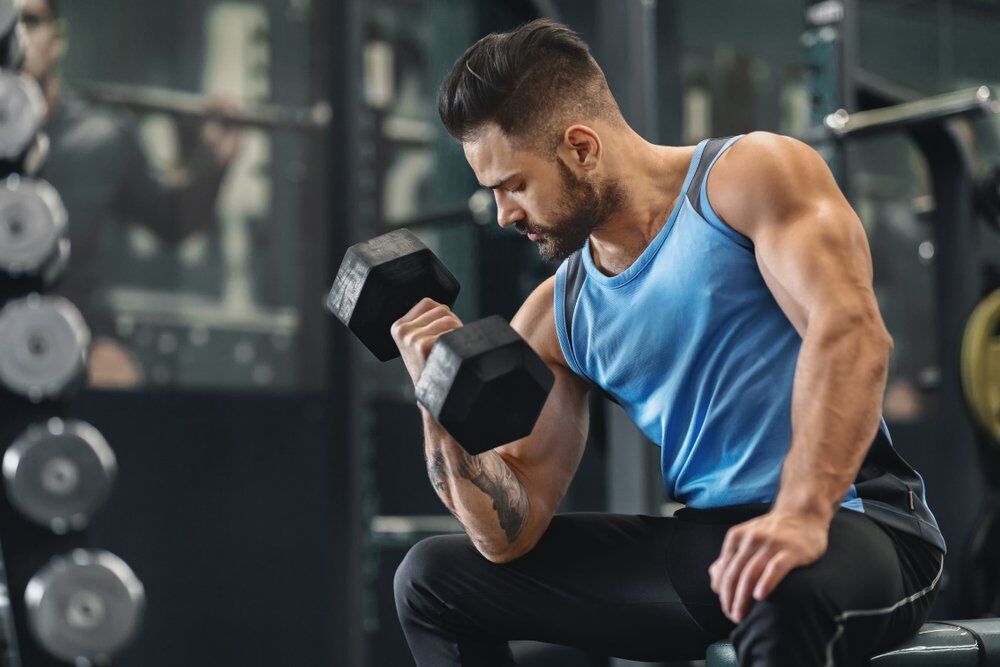
Top 10 Best Dumbbell Exercises To Target Your Full Body
Strength training doesn’t need to be complicated. Whether your goal is building muscle, fat loss, or improving your cardiovascular fitness – these can all be achieved by using just dumbbells alone! Ensure you maintain good form and use a weight that feels challenging (without compromising your form), you want those last few reps at the end of your set to be a struggle to get the most from your training. If it feels easy, gradually increase the weight until it feels more challenging.
Here’s 10 of our favourite dumbbell exercises:
Goblet Squats 
Why? Goblet squats are a fantastic full-body exercise, working your quads, calves, glutes, core, arms and grip. These are a great choice to increase glute strength and can be modified to target the glutes and hamstrings further by putting a weight plate under your toes to elevate them. This shifts the stress onto the back of your legs and glutes (known as the posterior chain) and increases the stretch on the hamstrings. If you’d rather target your quads, put a weight plate under your heels which will shift the stress onto the front of your upper legs instead.
How to do it:
- Stand holding the top of a dumbbell with both hands at chest level, palms facing (you want a challenging weight but one that still allows you to execute the movement correctly).
- Set your feet wider than shoulder width apart with your toes pointing slightly outwards.
- Brace your core and slowly sink your bum down into the squat, sitting your weight back (as if there’s a seat behind you) until your elbows reach the inside of your knees. Sit between your legs and open your hips, pushing your knees out.
- Keeping your feet firmly pressed into the floor, drive the weight back up in a powerful movement back to the standing position, squeeze your glutes at the top.
- Repeat with the rest of your reps.
Dumbbell Bench Press
Why? If you’re looking to build your chest, its recommended to opt for the dumbbell variety over using a barbell. This is because having a weight in each hand enables a greater stretch at the bottom of the lift, which helps to target the chest muscles more effectively. If you want a serious chest pump, utilise your mind muscle connection and really focus on squeezing your pecs together at the top of the lift to activate as many muscle fibres as possible. Find out more about how powerful the mind muscle connection can be when it comes to building muscle.
How to do it:
- Lie on the bench with a dumbbell in each hand and your feet flat on the bench (you can rest your feet up on the bench if that’s more comfortable).
- Push the dumbbells up so that your arms are directly over your shoulders and your palms are facing upwards.
- Pull your abdominals in and tilt your chin towards your chest. Lower the dumbbells down and outwards a little to the side until your elbows are slightly below your shoulders.
- Roll your shoulder blades back and down, as if you’re pinching them together and accentuating your chest, really visualise the squeeze.
- Push the weights back up, being careful not to lock your elbows or allow your shoulder blades to rise off the bench. Lower and repeat for the rest of your reps.
Bulgarian Split Squats
Why? There are several variations of split squats which are all effective at targeting the lower body. Split squats test your balance and coordination, build serious single-leg strength, warm up hip flexors and target the glutes. As well as working quads and glutes, this move also engages your hamstrings and calves and builds your core strength. As a single limb exercise, split squats are effective for increasing muscle activation, help to balance out any leg or glute muscle imbalances and prevent injury. Because both feet remain in contact with a surface throughout the exercise, you’re able to go a little heavier with the weight than you would with a lunge because you have much more stability.
How to do it:
- To begin, stand facing away from the bench, holding a dumbbell in each hand. Rest one leg behind you on the bench, with the front of your foot facing down (where your laces would be).
- Lower yourself downwards with your standing leg until the knee of the rear leg almost reaches the floor.
- Push back up, driving through from your front foot to return to the start position and repeat.
Seated Shoulder Press 
Why? The seated dumbbell shoulder press has many benefits, including increasing the strength and size of shoulder muscles, trapezius muscle (traps) and tricep muscles. When you perform the shoulder press in a seated position with your back pressed against the back of the pad, you remove any core activation, meaning that your shoulders and triceps will do all of the work. When you perform a shoulder press with dumbbells, this also allows for different angles to be stimulated compared to a traditional barbell.
How to do it:
- Holding a dumbbell in each hand, sit on a bench that has back support. Place the dumbbells upright on top of your thighs.
- Now, lift the dumbbells to shoulder height one at a time using your thighs to help elevate them up into position.
- Ensure you rotate your wrists so that your palms are facing forward. This is the starting position.
- Now, exhale and push the dumbbells upward until they touch at the top.
- After a brief pause at the top contracted position, slowly lower the dumbbells back down to the starting position while inhaling.
- Repeat for the rest of your reps.
Walking Weighted Lunges
Why? Walking lunges are considered to be a better form of lunges when compared to stationary lunges due to the impact they have on the leg and thigh muscles. Lunges are a unilateral exercise, meaning they work both sides of the body. This improves balance, coordination, flexibility, and can help to correct any imbalances you may have your glutes or leg muscles.
How to do it:
- Start by standing with your feet about hip-width apart and holding dumbbells in each hand down by your side. This is your starting position.
- Step forward with one leg, slowly lower yourself down until your rear knee almost touches the ground. Keep your posture upright throughout and keep your front knee in line with your front foot. Don’t allow your front knee to go forward past your toes as you lower down, as this will put undue stress on your knee joints.
- Drive through the heel of your front foot to raise yourself back up.
- Step forward with your rear foot, repeating the lunge on the opposite leg and continue until you have finished your reps on each leg.
- Why? Tricep extensions are a single-joint exercise which targets the triceps (the muscles on the back of the upper arm). The main benefits of tricep extensions are the isolation effect it has on the triceps. The triceps help to stabilise your shoulder joint and as your triceps become stronger with these exercises, the strength and stability of your shoulders and elbows will increase.
Tricep Extensions (Seated or Standing)
Why? Tricep extensions are a single-joint exercise which targets the triceps (the muscles on the back of the upper arm). The main benefits of tricep extensions are the isolation effect it has on the triceps. The triceps help to stabilise your shoulder joint and as your triceps become stronger with these exercises, the strength and stability of your shoulders and elbows will increase.
How to do it?
- Sit on a bench and hold one dumbbell with both hands directly above your head.
- Slowly flex your elbows and lower the weight behind your head as you keep your upper arms still. Extend your arms and repeat.
Renegade Row
Why? The renegade row (also known as a plank row) is a variation of a dumbbell row which is designed to target the upper back, shoulders, triceps, forearms, quadriceps, and like a plank, it also targets the core muscles. Due to the motion of the exercise, it also develops anti-rotational core strength which can help with stability, balance and coordination.
How to do it?
- Place the dumbbells on the floor, with the handles parallel to each other and positioned so they will be roughly shoulder-distance apart once your set up in the plank position above them.
- Start on your hands and knees, gripping one dumbbell with each hand. Your hands should be aligned beneath your shoulders and your knees under your hips.
- Step your feet behind you until you are in a full plank position, with your body supported by your hands and the balls of your feet. Make sure your body is forming a straight line from head to toe, with your core engaged and strong. Keep your feet roughly hip-distance apart to offer more balance and support to the exercise.
- Inhale and shift your weight slightly to your left side so more of your weight is supported by your left palm. Keep your core tight, your body shouldn’t twist so make sure both hips and shoulders remain square to the floor.
- Squeeze your right shoulder blade toward your spine and draw the dumbbell in your right hand toward your chest, bending your elbow as you draw the dumbbell toward your right chest/shoulder. Exhale as you lift the dumbbell. Make sure your hips and shoulders are still squared to the floor.
- Lower the dumbbell slowly to the floor, returning it to the starting position.
- Shift your weight to the opposite side and repeat the exercise, when you have completed the same movement on both sides, this counts as one full repetition. Repeat for the rest of your reps on each side.
Two arm Dumbbell Stiff Legged Deadlift
Why? Dumbbell stiff leg deadlifts ensure all of your posterior chain is working effectively and are one of the most effective free weight exercises to build up the lower body without risk of injury. They target the glutes, hamstrings and challenges both your obliques and rectus abdominis – key muscles of your core.
How to do it?
- Hold a dumbbell in each hand by your side at arm’s length.
- Begin with your torso straight and your legs around shoulder width apart. The knees should be slightly bent, this is your starting position.
- Keeping your knees stationary, slowly bend at the waist to lower the dumbbells to over the top of your feet while keeping your back straight. Keep bending forward as if you were going to pick something from the floor until you feel a stretch on the hamstrings, exhaling as you perform this movement
- Start bringing your torso back up straight by extending your hips and waist until you are back at the starting position, inhaling as you perform this movement. Repeat for the rest of your reps.
Lateral Raises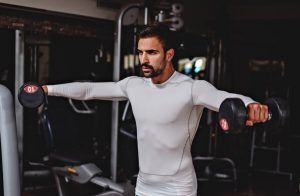
As well as developing stronger, larger shoulders, the lateral also increases shoulder mobility. If you brace your core correctly throughout the lift, your core will also benefit, along with muscles in the upper back, arms and neck.
How to do it?
- Stand (or sit) with a dumbbell in each hand at your sides. Keep your back straight, brace your core, then slowly lift the weights outwards to the side, until your arms are parallel to the floor, with elbows slightly bent.
- Slowly lower them back down, you’ll find it all the harder if you avoid speeding up. A lot of people cheat with this exercise by “shrugging” the weights up using their traps. If you want to target your shoulders, resist the urge to shrug them by not raising your shoulder blades during the rep – instead focus on your delts. Repeat to finish your reps.
Seated Bicep Curls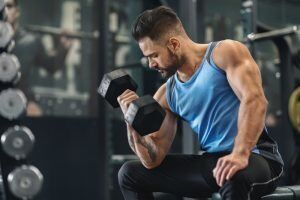
How to do it?
- Sit on a flat bench with a dumbbell in your hand being held at arm’s length. Your elbows should be close to the torso.
- Rotate the palms of the hands so that they are facing your torso, this is your starting position.
- While keeping your upper arm still, curl the weights upwards and start twisting the wrists once the dumbbells pass your thighs so that the palms of your hands are facing forward at the end of the movement. Make sure that you contract the biceps as you breathe out and make sure that only the forearms move (again, focus on using your mind muscle connection).
- Continue the movement until your biceps are fully contracted and the dumbbells are at shoulder level. Hold the contracted position for a second as you squeeze the biceps.
- Slowly begin to bring the dumbbells back to the starting position as your breathe in and as you rotate the wrists back to a neutral grip.Repeat for the rest of your reps.



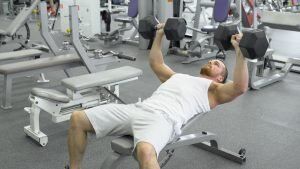
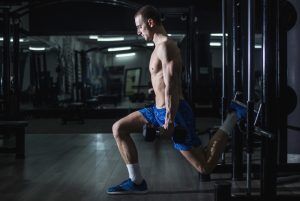
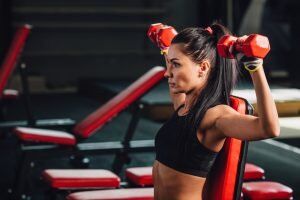






No Comments yet!